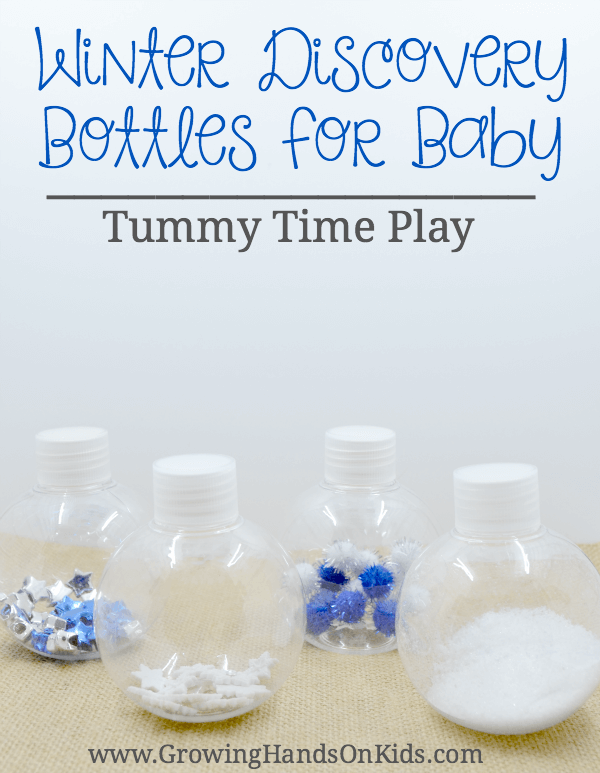The Importance of Tummy Time for Babies: A Therapy Blogger Blog Hop
Affiliate and Referral links are used below to promote products I love and recommend. I receive a commission on any purchases made through these links. Please see my disclosure policy for more details. As an Amazon Associate, I earn from qualifying purchases.
Is tummy time really that important for babies? Today a group of therapy bloggers and myself have gotten together to share our thoughts on tummy time for babies. Be sure to check out all their posts at the end of this post.
The post that I am sharing with you is a research paper I wrote in college while I was studying to be an Occupational Therapy Assistant. Since it was a research paper and was 8 pages long, I had to edit it to fit into this post. I am also including all my sources at the end so you can go research for yourself.
How Does the Back To Sleep Campaign Affect Tummy Time?
The term tummy time is a result of the “Back to Sleep” program that the American Academy of Pediatrics (AAP) started in 1992 when so many babies were dying of Sudden Infant Death Syndrome (SIDS).
First, let me give a definition and a little history on this subject.
SIDS is defined as: “The sudden, unexpected and unexplained death of an infant or young child.” (Dr.Greene.org). There is no known cause or cure for SIDS. As infant death from SIDS increased to 4,000-5,000 babies each year, researchers tried to find causes and ways to help reduce the risk of SIDS.
They found that babies who slept on their backs, instead of their stomachs, reduced the risk of SIDS dramatically. Once the AAP found out about this research, they started a campaign in 1992 to tell parents about this research and how they could reduce the risk of SIDS in their babies. They called it the “Back to Sleep” Campaign. (NICHD). Some of the things this campaign told parents to do is as follows:
- Place Infants on their back to sleep for naps and nighttime, in a safe crib, never on a couch, chair or other soft surface.
- Use a safety approved firm crib mattress covered by a fitted sheet.
- Keep all soft objects out of the crib such as stuffed toys, comforters, pillows, and quilts.
- Avoid over-heating baby by keeping baby’s room at a comfortable temperature and reducing covers.
(Infant And Child Loss.org)
This advice was sent to doctors and they, in turn, informed their new parent patients of the risk and of the “Back to Sleep” campaign. This news greatly relieved parents, who immediately began putting their babies to sleep on their backs. As a result, the rate of babies dying from SIDS dropped to 2500 deaths per year, a decrease of 40%, as of 2005 (Jennings, PT).
Even though the campaign said babies only needed to be on their backs to sleep, many parents became overzealous and feared putting their babies on their tummies at all, even when they were awake and supervised. Even though parents thought they were protecting their babies, which they were, from SIDS, adverse side effects of babies primarily being on their backs began to filter into doctor’s offices around the country.
According to Judy Jennings, a Physical Therapist with 20+ years of experience in Pediatrics and School-based therapy, the current statistics state that 1 in 300 or as many as 48% of “normal” babies are developing flat spots or Plagiocephaly on the back of their heads. They are also developing neck problems due to the excessive time they are spending on their backs.
If these problems go unchecked, the parts of the brain where the flat spot is, may not develop properly. They may also develop Torticollis which restricts the baby's head and neck movements and in turn, affects how they explore the world around them. Dr. Alan Greene also states on his website:
“The more hours that babies spent flat on their backs, the more likely they were to have head flattening. Even 5 minutes a day of tummy time had a protective effect.” (Dr.Greene.org)
Another group seeing the importance of tummy time has also issued statements concerning tummy time and the lack of importance the “Back to Sleep” program has placed on it:
“While the Back-to-Sleep campaign has reduced the risk of SIDS, it has overshadowed the importance of tummy time and it’s benefit to a baby’s development of motor control and planning, sensory integration, environmental awareness, and postural strength.” – Cranial Technologies
The effect of not getting tummy time as little babies become very evident when the child starts preschool or kindergarten. When a baby is young, there are specific motor and visual motor developmental milestones that are important to their overall development. Some of these milestones include the baby being able to lift and support its own head and neck against gravity, weight shifting up and over their body on their hands and arms, and discriminating between things close and far away.
This in turn helps develop strong abdominal muscles that allow them to sit up, stand, and eventually walk, be able to weight shift on just their legs, and track objects with their eyes. Once they have developed these core muscles, all other positionings they need to sit for school activities come easier and more natural. (Primary Children’s Medical Center).
This is where the problem lies with school-age children. Children in school are expected to obey the rules by sitting still when they need to and listening to the teacher in front of the class on the board.
Children who fidget in their seats and do not keep their eyes on the teacher when she is speaking are thought to be disruptive and hyperactive children. But can all this actually go back to the fact that these children have not developed these milestones when they sound have, and so have not developed the core muscle strength that allows them to sit and be able to concentrate when asked to.
Tips For Tummy Time
In review, some basic skills that tummy time helps to develop are:
- Crawling and scooting which leads to walking
- Balance and Coordination (which helps them in play and exploring their environment).
- Eye-hand coordination (writing, visual/motor skills, scissor skills)
- Calming (Allows children to concentrate on tasks they are asked to do in school work, like listening to a teacher at the front of the class).
- Confidence and Independence
(Blank Children’s Hospital)
With many educators, therapists, and doctors finding these facts, the AAP has since released new recommendations to parents, regarding SIDS and the “Back to Sleep Program.” One of these recommendations includes tummy time:
“Give baby “tummy time” while awake to strengthen head and neck. It will also help reduce the chances for a “flat head.” Place baby at alternate ends of the crib, with head to side for sleep. Reducing excessive time in car seat carriers and bouncers, and upright cuddle time will also help.” – AAP Policy Statement, October 2005.
Some things to look for in children who you think may have difficulty in school due to insufficient tummy time as infants are:
- Unable to concentrate in school (fidgeting, hyperactive
- Poor eye tracking (teachers may complain that the child does not seem to listen to them when they are up front or walking around the room giving directions).
- Difficulty in gross motor tasks (clumsy or uncoordinated children in gross motor play, poor desk posture [head on arm or on the table]).
- Difficulty crossing the midline of the body (Using the right hand for objects on the right side of the body, left hand for the left side of the body).
- Difficulty with fine motor tasks and special concepts, particularly with pre-writing lines and following lines, circle shapes etc.
- For Therapists – STNR and ATNR reflexes still present in gross motor tasks (not integrated)
If any or even one of these is present in a child you are seeing in the school system or at home, you may consider integrating tummy time into your therapy treatment or activities at home. Some way you can do this is by the following:
- While working on pre-writing lines and shapes
- Puzzles
- Clips and stringing beads
- Coloring and drawing
- Reading
- Cars
- Watching a movie or T.V.
More Tummy Time Activity Tips
Tummy Time Therapy Blogger Blog Hop
Below you will find all the posts in the Tummy Time therapy blogger blog hop. So many great ideas and thoughts on tummy time from Occupational Therapists and Physical Therapists.
Tummy Time and Baby's First Year – The Recycling OT
Awesome Toys for Tummy Time – The Inspired Treehouse
Terrific Tummy Time Positions – Your Kids OT
Tips for Tummy Time from a Physical Therapist – Pink Oatmeal
Tummy Time: The Basics – Therapy Fun Zone
Tummy Time: Developmental Consequences and Future Implications – Tools to Grow
Tummy Time Tips – Pediatric Occupational Therapy Tips
Tummy Time Just Isn't for Babies – Your Therapy Source
Tummy Time: More than Just a Buzz-Word – Starfish Therapies
Tummy Time Never Gets Old – Playapy
For more great OT Tips like this one, be sure to follow my Occupational Therapy Tips Pinterest board.
Resources:
Jennings PT MA, Judy. Lucht MPH, OTR/L, Peggy. “Parent Workshop On Readiness Skills.” May, 2006. www.fit-baby.com
Cranial Technologies. ”Babies & Tummy Time – Understanding the importance of Tummy Time.” June 1 2005. www.cranialtechnologies.com
Greene MD, Alan. “Flat Heads and Tummy Time.” October 18, 2004. http://www.drgreene.org/blank.cfm?id=21&action=detail&ref=1840
Healthy Child Care America. “Back to Sleep, Tummy to Play.” www.healthychildcare.org
Primary Children’s Medical Center. “Let’s Talk About… Tummy Time.” 2004.
Blank Children’s Hospital – Iowa Health System. “Tummy Time with Your Baby.” www.blankchildrens.org
Jennings PT, MA. Judy. “Why Vary Your New Baby’s Positions” Power-point. www.fit-baby.com
Author Unknown. “SIDS: ‘Back to Sleep’ Campaign.” National Institute of Child Health & Human Development. www.nichd.nih.gov/sids/
Author Unknown. “American Academy of Pediatrics Revises Recommendations to Reduce the Incidence of Infant Death.” The Center. 2005. www.infantchildandloss.org
AAP. “Changing Concept of Sudden Infant Death Syndrome.” American Academy of Pediatrics Policy Statement. October 10, 2005.
Greene MD, Alan. “Sudden Infant Death Syndrome.” May 31, 2002. www.drgreene.org

Heather Greutman, COTA
Heather Greutman is a Certified Occupational Therapy Assistant with experience in school-based OT services for preschool through high school. She uses her background to share child development tips, tools, and strategies for parents, educators, and therapists. She is the author of many ebooks including The Basics of Fine Motor Skills, and Basics of Pre-Writing Skills, and co-author of Sensory Processing Explained: A Handbook for Parents and Educators.






Hi Heather;
Our granddaughter Taylor, (now 12) was born with Wolf Hirshorne, Mitochondrial disease and due to very low head, neck and upper torso muscle strength tummy time was impossible. She would immediately start barrel rolling and this became her mode of locomotion. Our daughter searched everywhere as did her O/T and could find nothing to help. Long story short, we developed a product, the “Taylorbar” that truly solved the problem, you can see it on our website with three short “progress” videos. It keeps the child in the prone position, doesn’t interfere with arm/leg range of motion and is easily worn. We patented it in ’06 and have been manufacturing it in our home and selling it domestically and internationally to P/T, O/T’s and parents. We are extremely pleased with the help it has given to so many children. Thank you for your time.
Hi
Just wandering what evidence base studies there are exploring the lack of tummy time and it’s effects on children and their schooling? Thanks
Hi Angelina,
I will be looking into specific articles and research for you, but wanted to pass along this quick article that I found on APTA (American Physical Therapy Association). Quote from Judy Jennings, PT, MA “We have seen first-hand what the lack of tummy time can mean for a baby: developmental, cognitive, and organizational skills delays, eye-tracking problems, and behavioral issues, to name just some complications.” rest of the article here: http://www.apta.org/Media/Releases/Consumer/2008/8/6/
Hello
Do you have resource on early learning standards for 0-5 years
For physical
Language
Cognitive
Social/ emotional development ???
Or any resources for lessons plans for 0-5 development ?
Hi Vince,
I’m sorry, I don’t have any resources on the blog for those specific things. I do have some developmental milestone information for fine motor skills, but not the other areas you mentioned. A quick Google search could probably help you find those other areas. Thanks!